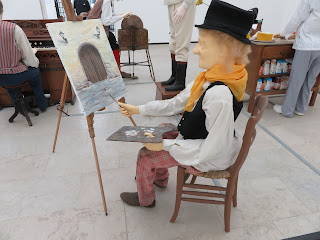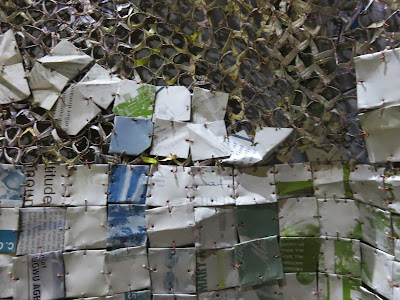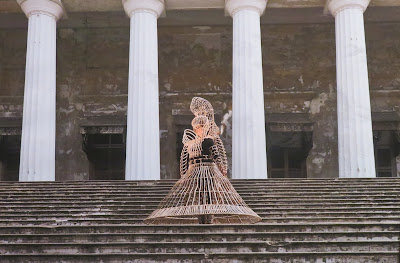The Biennale catalogue lists 26 national pavilions in the Arsenale. Those are in addition to the 29 official ones at the Giardini and the scores of them in apartments, shops, palaces, warehouses, and other venues hidden across the city. I’ve selected only a few that particularly caught my attention.

Because I made a couple of trips Amazon Peru in the ‘90s, starting in Iquitos, I was quite taken by Christian Bendayán’s rather complex installation in the Peruvian pavilion, “Indios Antropofágos”. A Butterfly Garden in the Jungle. Based on “exoticized images of jungle natives,” his Spanish tile compositions depicted transgender and transvestite characters enacting exaggerated versions of early 20th-century postcards of native people of Peru. Versions of the postcards, showing native Peruvians dancing or posing in groups are also included in this richly conceived installation. The backgrounds of the tile compositions copied watercolors of Iquitos – on view in the exhibition - by the lepidopterist Otto Michael, who published books on Amazon butterflies after three multi-year expeditions to Peru between 1885 and 1921. Michael’s books are also on display, titled “Butterfly Hunter of the Amazon,” and Bendayán has included collages of Amazonian women with butterfly wings. This is a rich and dense installation, full of history, anthropology, socology and biology, very rewarding if one takes the time to look carefully. And the tiles, azulejos, are brightly colored and cheerful.

The Luxembourg Pavilion included a vast installation by Marco Godinho,
Written by Water, of blank books that have been washed the water of various oceans. It is accompanied by a video documenting the books being washed by waves. The array of blank books, each a slightly different color of white and each with differently curled pages, was both peaceful and disturbing. Blank books, the ocean as a factor, and the whiteness of the pages call to mind bleaching coral and the power of the earth’s elements.
Kosovo’s
Family Album is a video installation by Alban Muja that captured my attention for many minutes, as adults describe the meaning and memories they derive from photographs of themselves as children displaced by the Kosovo War of 1998-99. Their straightforward descriptions of the events they survived and their calm demeanor made the stories chilling.
The Ukraine Pavilion was somewhat ephemeral, but engaging, especially to Tom. As their entry to the Biennale, Ukraine sent the worlds largest cargo plane the Antonov AN-225 MRIYA on a flight over Venice on May 9, 2019, casting its shadow over the Giardini del Biennale.
In the cargo hold was a digital directory of all living Ukrainian artists.
 |
| brochure cover about the Antonov 224 cargo plane |
The installation that touched me the most was another of multiple similar objects, this one from Saudi Arabia:
Zahrah Al Ghamdi’s
After Illusion. It refers to a line from an ancient Arabic poem by Zuhayr bin Abi Sulma (520-609) referring to his attempt to recognize his home after having been away for 20 years. The installation is made up of thousands or round, sea-form like sculptures made from leather, attached to translucent lighted white shims and clustered on the floor. It was pleasant to walk through, evoking a world of peace and artistic creativity.
Layers of suspended black paper made up the installation by Jo
ël Andrianomearisoa for the Madagascar Pavilion, that country’s first representation at Venice. It is beautifully simple, dark but not completely negative in feeling.
Latvian artist Daiga Grantina presented an installation of brightly colored forms suspended from the ceiling, leaning on the walls and resting on the floor, titled
Saules Suns. They seemed playful, organic, cheerful, and a little menacing.
Ghana also had its first representation at Venice and chose to make a substantial pavilion, designed by Sir David Adjaye, the Ghanian-British architect. Among several artists included there were Lynette Yiadom-Bonkye, a very good painter, Felicia Abban, a photographer, and the famous ubiquitour El Anatsui, with several enormous wall pieces made as usual, from bottle caps and the like. They were so big I couldn't capture them in photographs.
 |
| Felicia Abban, Untitled Self-Portraits, ca. 1060s-70s |
 |
Lynette Yiadom-Boakye, The Mighty, Mighty Lines, 2019, oil on linen
El Anazui, Yaw Berko, 2019, aluminum printing plates, bottle tops, and copper wires. |
Walking toward the end of the Arsenale, outdoors, we came upon a very old decrepit-looking boat, suspended near the water, obviously salvaged. We did not know at the time that this was the boat named Barca Nostra, which had sunk off the coast of Libya in 2015, drowning about 900 immigrants. The Swiss-Icelandic artist Christoph B
űchel had brought the boat to Venice. There are online images of it being transported to the lagoon.
Among the several large pavilions at the end of the Arsenale building, we were most interested in India. The installation,
Our Time for aFuture Caring, is based on the memory of Mahatma Gandhi. It opens with images of Gandhi and a quotation from him, “I am not a seer, rishi or philosopher of non-violence; I am only an artist on non-violence and desire to develop the art of non-violence in the realm of resistance,” Mohandas Karamchand Gandhi. The works of several younger artists and senior artists like Nandalal Bose, all refer to Gandhi’ s teachings and impact on India. I’ve chosen to focus on just two. The first installation, by GR Iranna,
We Together, 2012, two walls full of single Indian sandals of the type worn by Gandhi, is another example of repeating the same element, in this instance peasant sandals, to larger effect than just a few sandals, a photograph or a painting would have. To me it spoke of all the kinds of people who wear this footwear, and all the walking Gandhi and his followers, and Indians, do.
Of Bodies, Armour, and Cages by Shakuntala Kulkarne, includes several cane dresses, headdresses and other forms, as well as photographs of women wearing the dresses. While being beautifully and artfully constructed, the works speak profoundly of women’s real and imagined constrictions.
 |
GR Iranna, We Together, 2012
Shakuntala Kulkarni, Of Bodies, Armour, and Cages, 2010-2012
|
If you wonder where the Italy and China pavilions are, I did not photograph any of the works in these two very large venues. I did make a point of seeing the installation by Tom
ás Saraceno, an artist whose work has fascinated me since I first saw it at an earlier Biennale.
On the Disappearance of Clouds, in one of my favorite parts of the Arsenale complex, relates conceptually to the effects of global warming, apparently moving with the motion of the tides, and accompanied by scores for music compositions on the same subject, these clouds were not as evocative as the webs we have seen by Saraceno in Venice and other venues. And I discovered, this installation was part of the curated exhibition. Some things were not very clear as we wandered through the spaces.

 Walking around the monastery became surprisingly moving, just via paintings in blocks of richly muted colors. Even now, looking at some of my images and the details showing his brush strokes, I feel a tightening in my chest.
Walking around the monastery became surprisingly moving, just via paintings in blocks of richly muted colors. Even now, looking at some of my images and the details showing his brush strokes, I feel a tightening in my chest.





















































